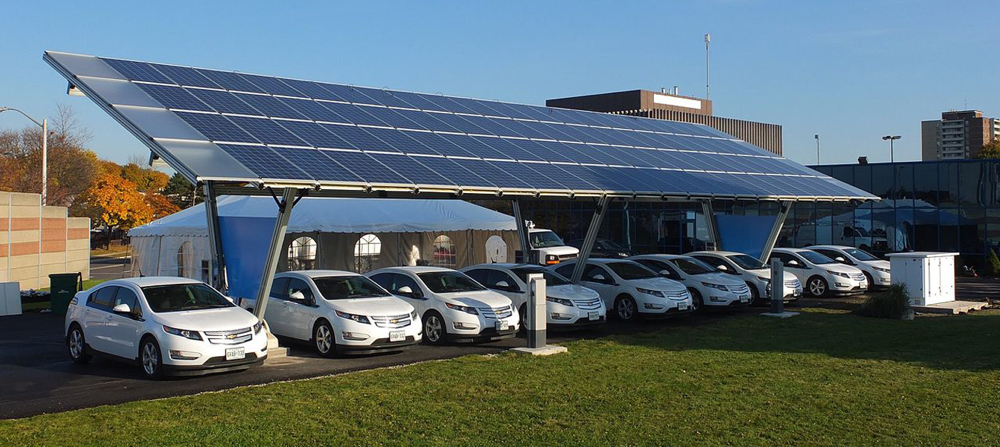 There have been lots of people asking why the makers of plug-in vehicles, other than Tesla, aren’t getting more involved in charging infrastructure roll-out. I wrote about the business model for charging infrastructure, shortly after getting our first two Chevy Volts. I was considering starting a business that installed and operated EV chargers. The path to profitability did not seem viable to me. In fact, it seemed so difficult to achieve profitability, that I still don’t understand how these companies plan to survive! In Texas, there’s an added obstacle: Only energy retailers can sell electricity to the public on a per-kWh basis and the EV charging companies do not meet that standard (unless the law gets modified). In order to resolve this, many EVSE companies have based charging on time connected. This places an undue burden on EVs that charge more slowly than others. For example, the Gen 1 Chevy Volt charged at about half the speed of a Gen 1 Nissan Leaf. By charging, based on connect time, it’s as if one gasoline-powered vehicle was charged twice as much per gallon than a different gasoline-powered vehicle.
There have been lots of people asking why the makers of plug-in vehicles, other than Tesla, aren’t getting more involved in charging infrastructure roll-out. I wrote about the business model for charging infrastructure, shortly after getting our first two Chevy Volts. I was considering starting a business that installed and operated EV chargers. The path to profitability did not seem viable to me. In fact, it seemed so difficult to achieve profitability, that I still don’t understand how these companies plan to survive! In Texas, there’s an added obstacle: Only energy retailers can sell electricity to the public on a per-kWh basis and the EV charging companies do not meet that standard (unless the law gets modified). In order to resolve this, many EVSE companies have based charging on time connected. This places an undue burden on EVs that charge more slowly than others. For example, the Gen 1 Chevy Volt charged at about half the speed of a Gen 1 Nissan Leaf. By charging, based on connect time, it’s as if one gasoline-powered vehicle was charged twice as much per gallon than a different gasoline-powered vehicle.
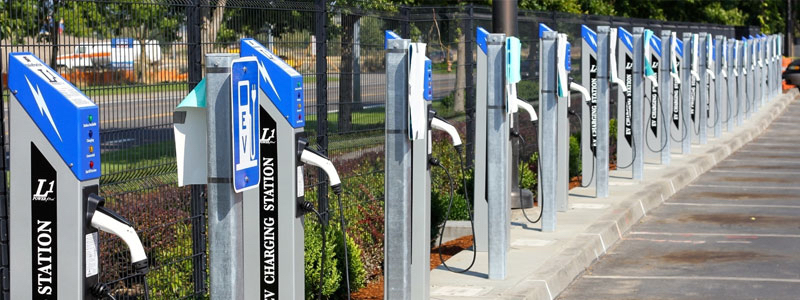 Looking back, five years later, I’ve realized a few things:
Looking back, five years later, I’ve realized a few things:
- Plug-in hybrids do not need to charge on public chargers. There, I said it. Better yet, I’ve lived it. In over five years of driving Volts, I have plugged into a public charger under five times, mostly out of curiosity. WHY would I want to be stuck at a public charger to add ten miles of range for each hour I was charging? I can just pull into a gas station and fill up, if my battery won’t get me home.
- EV etiquette arguments spring up with shorter-range BEV drivers (Leaf, Spark, iMiEV, etc) complaining that they can’t get home because a hybrid was plugged in. The hybrid camp responds with, “Exactly! That’s why we did the ‘smart’ thing and bought a hybrid.” P.S. The correct answer is, “You’re right. Since you asked politely, I will give up the charging spot to you. I’d rather drive home on gasoline than give the anti-EV crowd another nonsense issue with which to dissuade others from buying plug-in vehicles.“
- I believe the newer, longer-ranged EVs, when being used for driving less than 200 miles per day, also will not have a real need to charge at public chargers. If the owner can charge at home, doing so will open up charging stations to those who cannot charge at home (like apartment dwellers).
- Our government entities are planning on using budget for DC fast-charging infrastructure to build them, primarily, in large, metropolitan areas. This is where they believe the chargers will be most needed because that’s where the EVs are located. That’s fine for Level 2 chargers, since an EV in a large city, is probably less than 25 miles from home and a one hour charge would satisfy that need. But the most critical need will be between major cities, to help EVs make it from one city to another. This is what Tesla has been building: “Destination chargers.” Being from the western U.S., where there’s hours of driving between major cities, I may have a regional bias here…
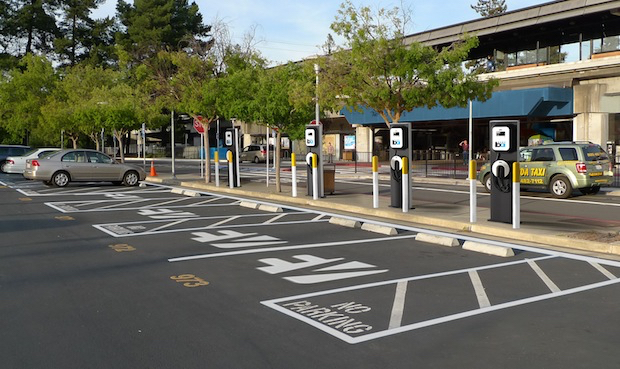
- We need to be smarter about charging locations: Here are some things to consider:
- Charging centers cannot replicate gasoline filling stations. Have you ever been to a gas station and thought, “This would be a great place to hang out for a couple hours!”?
- There has to be another attraction, that the EV owner would actually want to use, to fill the charging time and add revenue for the charging station owner. A movie theater and restaurant are good starts. However, movie theaters probably won’t work for destination chargers, as people will show up at all times, not just when a movie is about to start. To facilitate this, you need the ability to stream a movie from the EVSE to the EV’s infotainment system or passengers’ tablets/phones. In this way, the movie starts right when you arrive. This adds another revenue stream to support the cost of the charger.
- A nice club, like frequent flyer clubs in airports, could be nice. Very clean, quiet reading rooms, restrooms and nice grounds for picnicking, game rooms/arcades, swimming pools, and gyms would be something most EVers would ante up for. Trailheads with chargers (or buses that go to and from the chargers to the trailheads) for nice one to two hour hikes would be a big hit.
- These “destination chargers” could be a boon to a small town (since that’s where they’d be located). A nice, downtown shopping area, that could be strolled through, would be an invitation for EV owners and their disposable income to stay a little longer…
- The destination chargers need to be located where they can do the most to push the evolution of transportation forward. Getting to Colorado from east Texas is very difficult because there are no DC Fast Chargers available to the average EV in the Texas panhandle. Due to this, the EV driver has to plan a route that takes them days out of their way, or find hotels/RV parks, with chargers or outlets available for charging overnight. THIS sounds like an obstacle AND an opportunity for small towns who wants to attract visitors.
- It would be nice, if there was a small EV-specific garage at the destination chargers. Someone who could top off battery coolant, replace or repair leaking tires, replace 12V batteries, etc. Concerns about getting basic EV service in a small town is surely holding back some buyers.
- These chargers are not going to help move the switch to fun, clean EV driving, unless they are available. Every state needs to have tough fines/towing laws on the books for vehicles (both plug-in and non-plug-in) that are parked at a charger but not charging. There should be a timer, showing time since charging ceased, to prevent fining someone who got back a little bit late. There should also be video surveillance of the site, for the safety of nighttime charging.
- One last thing that would help: Each charger should have multiple connectors so that the next driver (and the next?) could go ahead and plug-in, knowing that their EV will wait until the previous EV is through charging, before their EV will begin charging. This can make each charger’s utilization climb because, as long as the next EV is in line and plugged in, the charger will experience no downtime or lost revenue.
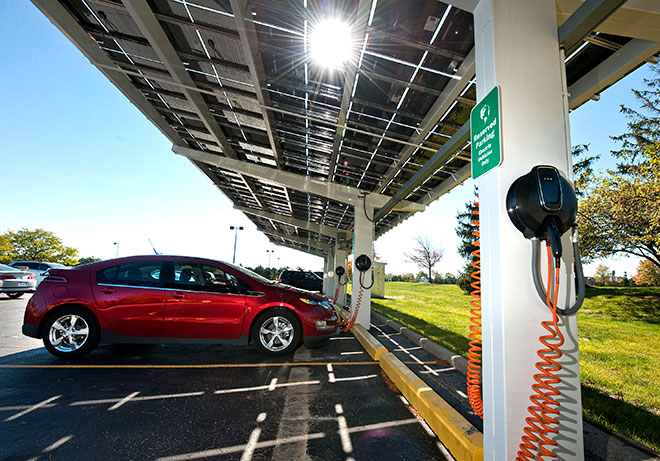 Now, who is to responsible for all this infrastructure?
Now, who is to responsible for all this infrastructure?
- The EV manufacturers (some, very late to the EV game) are up to their eyeballs in developing new EVs and trying to get to profitability. I don’t expect much from their camp.
- The EVSE manufacturers will probably continue to try to ally themselves with EV manufacturers and offer free charging or free memberships. I’m not sure this will do much for those who have already owned a plug-in vehicle, but it will help ease fears of new EV buyers.
- The government is getting money from the Volkswagen “diesel-gate” scandal and is applying a lot of that to charging infrastructure. Now might be a good time to use some of that to build destination chargers in a small, strategically located town and getting the town to develop surrounding attractions to grow with the charging site. By doing this, we will quickly determine what works and what doesn’t, in added attractions and revenue streams.
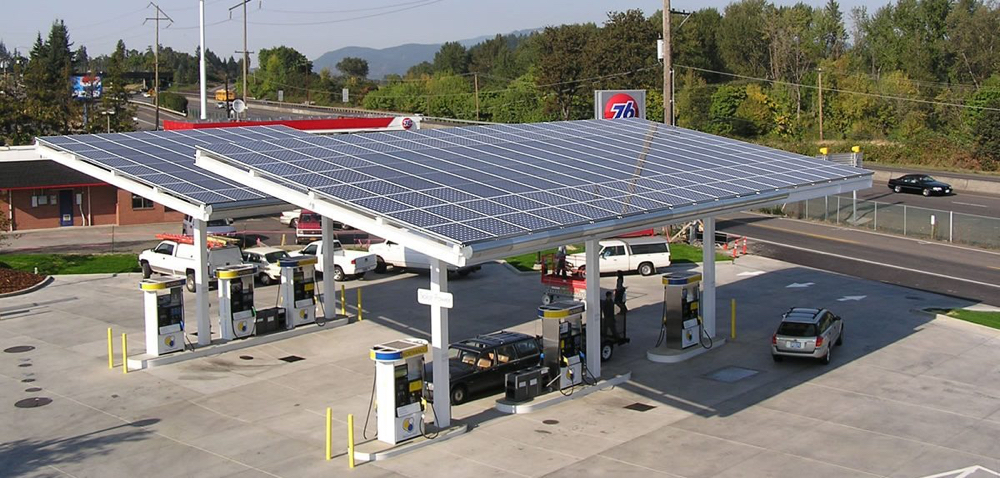



I like the notion of having multiple cords at each station so multiple cars can already be in line for when the original car is full.
But I’ suggest one step further. Make it possible for their to be some tiered charging. For instance, you don’t really need the charge but the charger is available so you plug in. Then another car comes that desperately needs that charger to get home. The convenience charger guy would be paying nothing or a small fee, but the desperation charging guy would be willing to pay more and thus cut in front of the “convenience” guy. To be fair, the “convenience guy would be offered the continued charge but at the much higher charge.
I see this problem coming up in the future when a parking lot might have 20 chargers but only have enough electricity to feed 6 or 8 cars at once. If 20 EVs showed up there would need to be a way to apportion the chargers and simply first come first served doesn’t cut it when some don’t really need the charge and others desperately do (and would be will to pay a premium for it)
When the EV owner first plugs in, the charger screen could ask a few questions so that EV owner wouldn’t start getting multiple emails/texts after they walk away from the charger. Just some thoughts
Zoos and museums would be good locations for L2s. These get local and regional visitors.
I drive about 40 miles to a children’s museum for the grandchildren. I use free L2 charging there when they are not full. There are 7 L2s for 14 stalls. Sometimes I get a stall but L2s are used. We then go to the library first, then stop back by and usually can pull a non charging L2. I consider not using my ICE a higher priority than leaving the spot open and taken most likely by another PHEV.
Another reason to use public L2s is to demonstrate the number of EVs out there and to encourage more L2s and DCFCs to be installed. I am shocked that a local upscale mall that has thousands of parking stalls and 4 L2s, and 6 Teslas stalls (just put in a Tesla store), often has an L2 available for me to plug in. We usually go at end of store hours to get steps in since its too cold to walk outside.
PHEVs giving up free public charges for EVs will not happen. Only pay-for will provide more access. Just like on street public parking near retail should cost more than further away garage parking.
Agree DCFCs should go to for long distance to bridge destination gaps.
I don’t understand a viable business model either for a charging business. Just makes sense for having a Volt to sail over the infrastructure turbulence until the EV max distance and charging options get worked out.
It cost me over $9 to charge at a Blink charger when we owned a 1st gen Volt. Never did that again. You will find us at Khols where it is free (if they have one) or Grapevine Mills Mall (free). Other free ones out there, but just not paying way more than gas to charge. We now have a Focus EV and sometimes need to charge while out to get home. Will go out of our way if needed to avoid charging for a fee.
It’s true Volts don’t need to plug-in at an EVSE but in the rare cases where they are free, why not?
The only reason to not charge, when it’s free, is consideration for EV drivers who cannot get home without a charge. A sign on the Volt, stating that it’s ok to unplug it would suffice.
A travel center gas station model works great for EVs. We’ve already road tripped twice in our Bolt. Both times we used DCFC while on the road. The best way to charge on the road is to drive 100-150 miles, stop to eat/stretch legs, plug in for 20-40 minutes as needed, and move on. Don’t wait until your car is at 100%.
This is what a lot of people do at “truck stops” or “travel center” gas stations already. They have restrooms, shopping, restaurants, etc. I think a company like Flying J or Buccees would be great to partner with. I can kill 30 minutes in a Flying J easily. But we also appreciated the EVgos at malls outside of San Antonio and Austin (similar to Grapevine Mills mall in Dallas.)
Of course, as an EV driver, no one is going to ask me my opinion on what to do with the VW money. lol Politicians and non-EV drivers will make that decision.